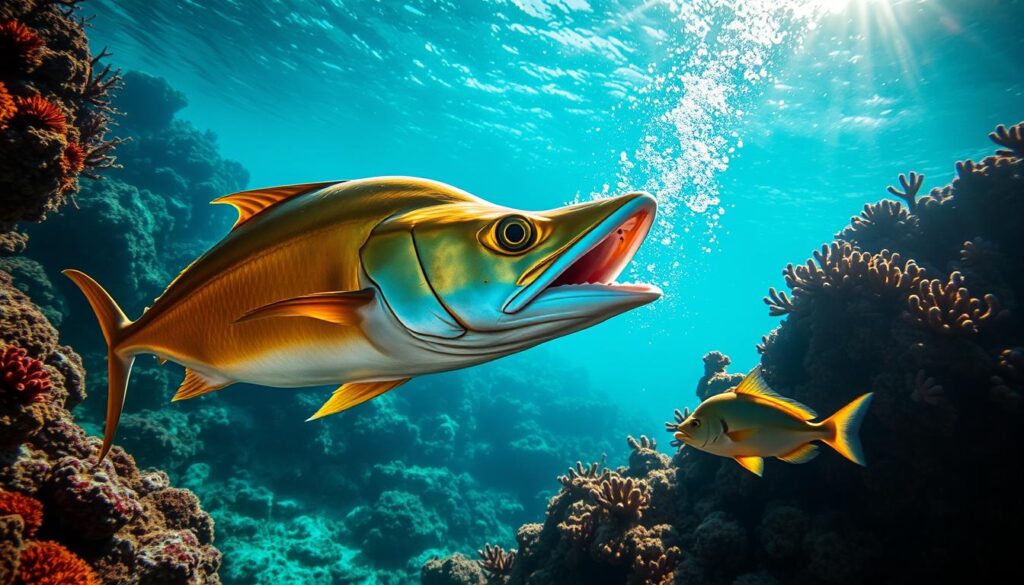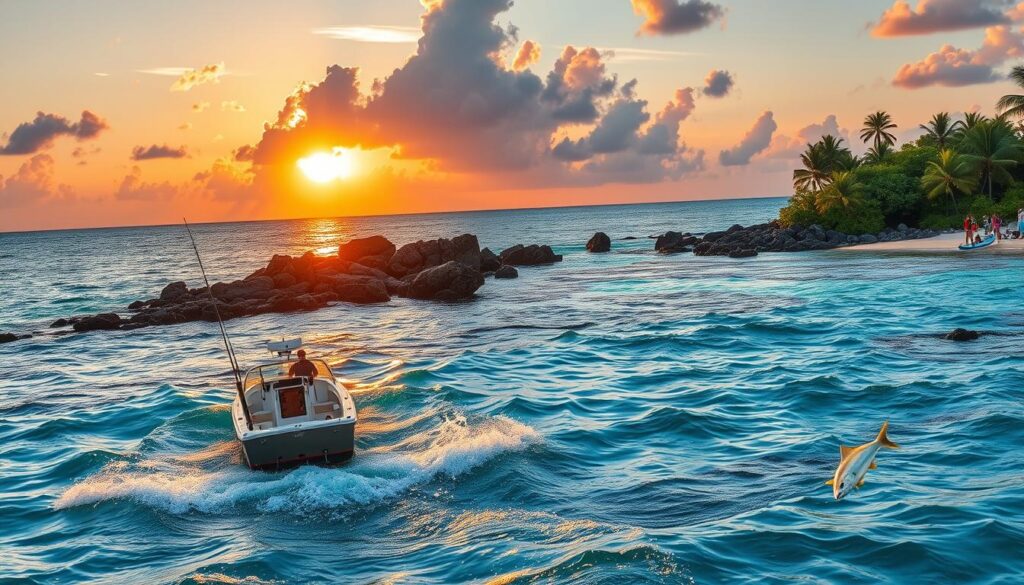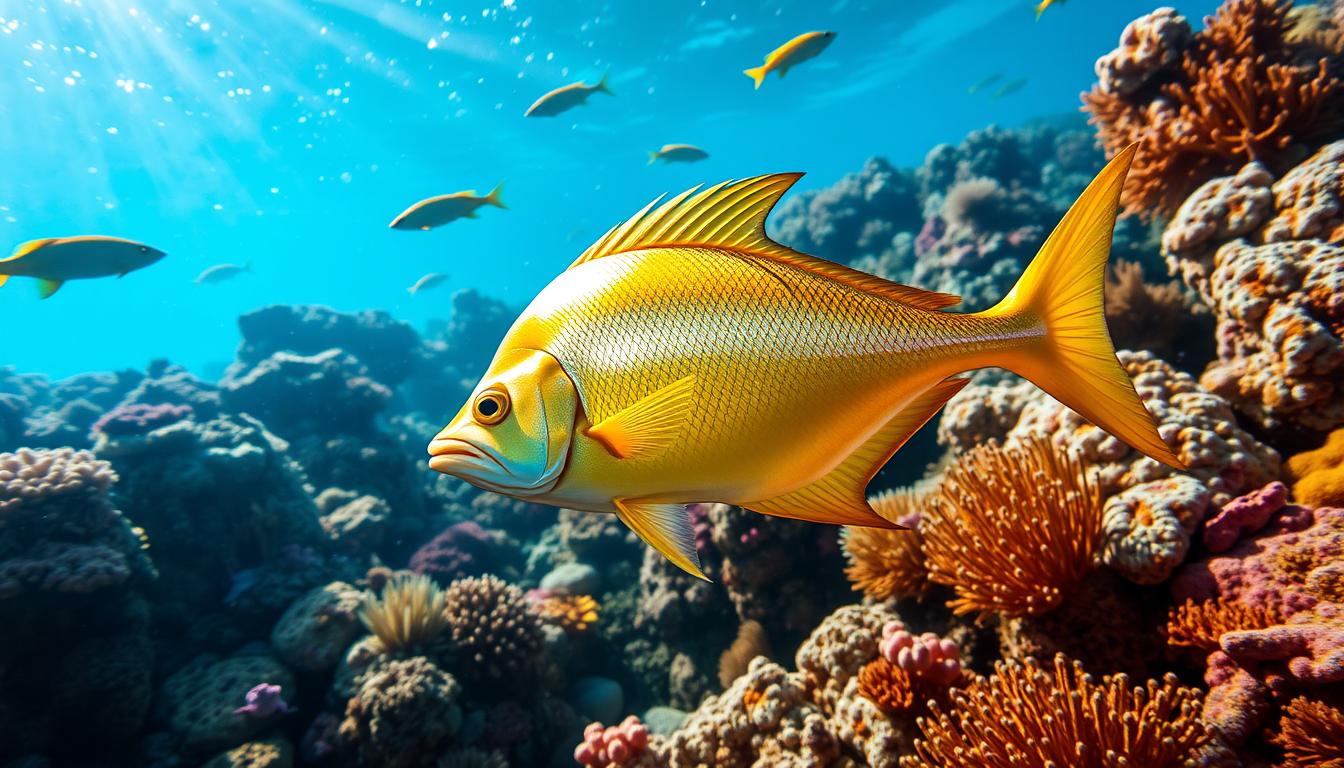Ever heard of the mahi-mahi, also known as the dorado fish or dolphinfish? These fish are known for their bright colors. They have yellow, green, and blue hues. But what makes them so special?
They are big and grow fast. They are also great hunters. These traits make them stand out in the ocean.
What secrets do these ocean predators hide? Let’s explore the world of the dorado fish. We’ll learn interesting facts that make them unique.
Table of Contents
Understanding the Magnificent Mahi-Mahi
The dorado fish, also known as mahi-mahi or dolphinfish, is a stunning pelagic fish. They live in tropical and subtropical waters worldwide. Sportfishing fans love them for their strength, acrobatics, and tough fights.
Scientific Classification and Names
Dorado fish are part of the family Coryphaenidae. In Hawaii, they’re called mahi-mahi, meaning “very strong.” In Latin America, they’re known as dorado, which means “golden” in Spanish. Males have big, square heads, while females have rounder heads.
Physical Characteristics
Dorado fish have a sleek, streamlined body. They have a long dorsal fin from head to tail. Their colors are bright, ranging from blues and greens to gold and yellow, making them a sight to behold.
Size and Growth Rates
These fish grow fast, reaching up to 4.5 feet long and over 50 pounds. They’re among the fastest-growing fish, reaching maturity in 4 to 5 months. This helps them fight off overfishing.
| Metric | Value |
|---|---|
| Maximum Length | 4.5 feet (1.37 meters) |
| Maximum Weight | Over 50 pounds (22.7 kg) |
| Top Swimming Speed | 50 miles per hour (80 km/h) |
| Time to Sexual Maturity | 4 to 5 months |
Habitat and Distribution Worldwide
The dorado fish, also known as mahi-mahi, live in warm tropical and subtropical waters all over the world. They can be found in the Atlantic, Pacific, and Indian Oceans. Places like the Caribbean Sea, Gulf of Mexico, and Central America’s coasts are home to them.
These fish live in the open ocean and often hang out with floating debris, seaweed, or sargassum mats. Their home is the ocean’s surface, near the coast and offshore fishing spots. Their wide range and ability to adapt make them key to marine biology and tropical waters health.
Research shows that dorado fish live in tropical and subtropical waters across the Atlantic, Indian, and Pacific Oceans. They are found between latitudes 46°N and 38°S in the western Pacific. People love them as a gamefish and for their meat, which is sold fresh and frozen.
Mahi-mahi, the scientific name for dorado fish, can grow up to 2 meters (6.6 feet) long and weigh up to 40 kg (88 pounds). They like tropical and subtropical waters in the Atlantic, Indian, and Pacific Oceans. They are common in the Caribbean Sea, Gulf of Mexico, and off Central and South America.
The Life Cycle of Dorado Fish
The dorado fish, also known as mahi-mahi or dolphinfish, has a fast life cycle. They grow quickly and reproduce efficiently. These ocean predators reach sexual maturity in just 4-5 months. This shows the fish biology that supports their thriving populations.
Reproduction Patterns
Dorado fish are prolific spawners, releasing thousands of eggs at once in warm ocean currents. This high marine reproduction rate helps the species survive. Females can spawn multiple times a year, making the dorado’s population more resilient.
Growth Stages
Dorado fish grow from larvae to juveniles and then to adults. They grow at an impressive rate. They can weigh between 15 to 35 pounds, with some reaching up to 50 pounds.
Average Lifespan
In the wild, dorado fish live for 4 to 5 years. This shows their adaptability and ability to survive in different marine environments. Their average lifespan highlights their role in maintaining the ocean’s ecosystem health.
| Characteristic | Dorado Fish |
|---|---|
| Average Size | 3–10 kg (6.6–22.0 lb) |
| Maximum Recorded Size | 1.3 m (51 in) length, 34 kg (75 lb) weight |
| Average Lifespan | 4-5 years |
| Sexual Maturity | 4-5 years old |
| Fecundity | Up to 2 million eggs per spawn |
| Preferred Water Temperature | 20-28°C (68-82°F) |
Hunting and Feeding Behavior
Dorado fish, also known as mahi-mahi or common dolphinfish, are powerful predators. They play a key role in the marine food chain. These fast-swimming fish feed on a variety of smaller aquatic creatures.
As opportunistic feeders, dorados target small fish, juvenile pelagic species, squid, shrimp, crabs, and even flying fish. Their speed, reaching up to 55 miles per hour, helps them catch prey efficiently.
Dorados hunt in schools when there’s plenty of prey. This is often near floating debris or seaweed. Schooling allows them to overwhelm and catch prey more easily.
The dorado’s role as a top predator is vital to the marine ecosystem. By preying on smaller fish, they help keep populations balanced. This contributes to the health of the ocean.
| Prey Species | Hunting Behavior |
|---|---|
| Small fish, juvenile pelagic fish (including tuna and billfish) | Opportunistic feeding, often in schools when prey is abundant |
| Squid, shrimp, crabs | Utilizing their speed and agility to chase and capture prey |
| Flying fish | Predation on fish that take to the air to escape |

Remarkable Physical Adaptations
Dorado fish, also known as mahi-mahi, have amazing physical traits. They can change colors thanks to special cells called chromatophores. These cells are linked to their nervous system.
Underwater, dorado fish look vibrant yellow. But when they get excited or feel threatened, they turn neon blue. This color change is a key survival strategy for these marine biology species.
Swimming Capabilities
Dorado fish are known for their fast swimming and agility. These traits are vital for hunting and avoiding predators. Their bodies are shaped like torpedoes, and they have big dorsal fins. This helps them swim fast through the ocean.
Sensory Systems
Dorado fish have advanced sensory systems for survival. They have great vision to find and track prey. They can also see their surroundings well.
They also have a lateral line system. This is a series of sensory receptors along their bodies. It helps them feel movements and changes in water pressure. This makes it easier for them to detect threats and find food.
| Adaptation | Description |
|---|---|
| Color-Changing Abilities | Dorado fish can change colors from yellow to neon blue due to specialized cells called chromatophores, which are connected to their nervous system. |
| Swimming Capabilities | Dorado fish have streamlined, torpedo-shaped bodies and large, powerful dorsal fins that enable them to swim swiftly through the open ocean. |
| Sensory Systems | Dorado fish possess excellent vision and a lateral line system that allows them to detect movements and changes in water pressure, enhancing their ability to locate prey and navigate their environment. |
Prime Fishing Locations and Seasons
If you love sportfishing, you’ll be excited to find the best fishing destinations for Dorado fish. This powerful ocean predator is found in several coastal areas. Each place offers something special for anglers looking for a thrilling experience.
Costa Rica is a top spot for sportfishing Dorado. The green season, from April to September, is the best time. During this period, the waters are warmer, and there’s more debris from rivers. This attracts Dorado looking for food.
Mexico’s Yucatán Peninsula is also great for Dorado fishing. The best months are April to September. Anglers focus on areas with floating objects or debris. These spots draw smaller fish, which Dorado feed on.
In Hawaii, the winter months (December to January) and April to June are the best for Dorado fishing. Anglers look for areas with floating objects or debris. These spots attract baitfish, which Dorado love to eat.
Panama is another excellent fishing destination for Dorado. The green season months bring plenty of fish. Anglers can expect an exciting fight with these powerful, acrobatic fish.

Knowing the best fishing locations and seasonal fishing times for Dorado helps plan your next sportfishing trip. Whether in Costa Rica, Mexico, Hawaii, or Panama, catching a Dorado is an unforgettable experience for any angler.
Essential Fishing Techniques and Equipment
Dorado, also known as mahi-mahi, are powerful ocean predators that captivate anglers worldwide. To successfully target these vibrant fish, employing the right fishing techniques and equipment is crucial. Whether you’re trolling, spinning, or fly fishing, understanding the essentials can make all the difference in your dorado fishing endeavors.
Recommended Gear
For dorado fishing, medium to heavy spinning rods or trolling rods paired with 20-50 lb test lines are recommended. Quality reels with a smooth, sealed drag system are essential to handle the dorado’s explosive bursts of speed and strength. Anglers should consider investing in durable, corrosion-resistant gear that can withstand the rigors of offshore fishing.
Bait Selection
Effective lures and baits for dorado are those that mimic their natural prey. Bright colors like greens, blues, and yellows tend to be particularly enticing. Live bait options such as mackerel, ballyhoo, or sardines can be highly effective in attracting dorado’s attention and triggering their predatory instincts.
Trolling Methods
Trolling is a popular and productive technique for catching dorado. Anglers should aim for speeds between 6-10 knots, allowing the lures or baits to entice the fish as they cruise near the surface. Chumming the water can also be an effective way to draw dorado to the boat, stimulating their feeding behavior.
| Fishing Technique | Recommended Gear | Bait/Lure Options | Trolling Speed |
|---|---|---|---|
| Trolling | Medium to heavy spinning or trolling rods, 20-50 lb test lines | Bright-colored lures, live bait (mackerel, ballyhoo, sardines) | 6-10 knots |
| Spinning | Medium to heavy spinning rods, 20-50 lb test lines | Spoons, crankbaits, jerkbaits | N/A |
| Fly Fishing | 9-weight saltwater fly rods, large streamers | Streamers (4-8 inches), top-water flies | N/A |
Remember, dorado are known for their vibrant colors, acrobatic leaps, and aggressive feeding behavior. By mastering the right fishing techniques and utilizing the proper equipment, anglers can increase their chances of landing these magnificent ocean predators.
Nutritional Value and Culinary Uses
Dorado fish, also known as mahi-mahi, is packed with nutrients. It’s a lean protein, low in saturated fats, and full of omega-3 fatty acids. These fats are good for your heart. Dorado also has vitamin B12, phosphorus, and selenium, making it great for a healthy diet.
The culinary fish flesh of dorado tastes mild and slightly sweet. It’s firm and can be cooked many ways. You can grill, pan-sear, or eat it raw as sashimi. This makes it perfect for a variety of dishes. It’s especially loved in many cuisines, often used in ceviche.
| Nutritional Facts (per 100g) | Dorado Fish |
|---|---|
| Calories | 120 kcal |
| Protein | 20-22 g |
| Fat | 4-6 g (less than 1 g saturated) |
| Cholesterol | 60-70 mg |
| Vitamins and Minerals | Vitamin B12, Vitamin D, Selenium, Phosphorus, Potassium |
Dorado fish is a favorite among those who care about their health and taste. It’s a delicious and nutritious choice for any meal.
Conservation Status and Environmental Challenges
Dorado fish face different challenges in different places. Some areas have stable populations, but others are threatened by overfishing and habitat loss. Climate change and pollution also harm their homes.
Commercial fishing is a big problem. Dorado fish get caught by accident, hurting their numbers. Efforts are underway to fish sustainably, protect habitats, and teach people about these fish’s value.
Current Population Status
The Dorado, also known as the gilded or “dorado” fish, is now considered vulnerable. Its home range has shrunk by 37% because of dams in the Amazon Basin.
Threats to Survival
Dorado fish migrate an incredible 11,000 kilometers (6,800 miles) each year. But dams block their way, making their journey almost impossible. In Bolivian rivers, their numbers have dropped by over 70%.


1 thought on “Dorado Fish: Facts About This Powerful Ocean Predator”